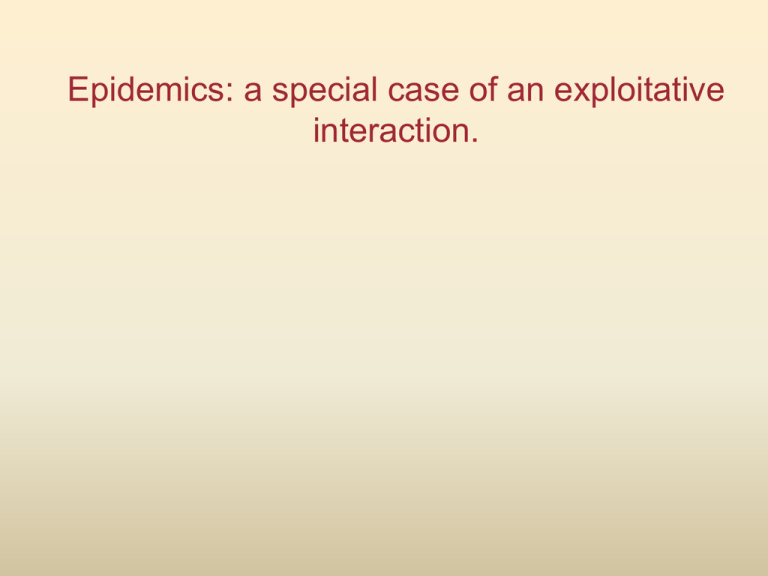PowerPoint - Susan Schwinning
advertisement

Epidemics: a special case of an exploitative interaction. Bubonic plague (the black death, pestilence) Yersinia pestis Population of Europe in millions 1000 1100 1200 1300 1347 1352 1400 1430 38 48 59 70 75 50 45 36 "How many valiant men, how many fair ladies, breakfast with their kinfolk and the same night supped with their ancestors in the next world! The condition of the people was pitiable to behold. They sickened by the thousands daily, and died unattended and without help. Many died in the open street, others dying in their houses, made it known by the stench of their rotting bodies. Consecrated churchyards did not suffice for the burial of the vast multitude of bodies, which were heaped by the hundreds in vast trenches, like goods in a ships hold and covered with a little earth." -Giovanni Boccaccio (author of The Decameron) Dracula – the plague carrier Ring around a rosie Pocket full of posies Ashes ashes We all fall down Plagues described in the old testament consistent with the black plague First certain outbreak 430 BC in Athens estimated death toll 30% (beginning of the end of Greek Empire) First pandemic: a series of repeated epidemics between 541 and 750 affected the Middle East to the Mediterranian (weakened the Byzantine Empire). Second pandemic: 1346-1351. Estimated dead in China: 50%, estimated dead in Europe; 30%. Followed by cyclical outbreaks for >200 years Third pandemic: 1855 – 1900. From China to India, Africa, Australia, Europe, Hawaii, India, Japan, the Middle East, the Philippines and North and South America Caffa, (today’s Feodosia in the Ukraine), Genoese traders had a fortress which was besieged in 1347 by Mongol armies. The Mongols carried the disease and catapulted dead bodies over the fortress wall. The Genoese fled home… After the original epidemic, it revisited Europe once in almost every generation for 600 years. • Most cases were more localized hitting individual cities • continuing high death toll of 30-40% • Last outbreak of that era in Marseilles (1720), when a commercial ship named the `Grand Saint-Antoine' arrived from Syria and Lebanon with cases of plague aboard. This epidemic killed 50,000 people. Questions arise from the study of European epidemics: How do new epidemics suddenly appear? Why do they disappear as suddenly? Why can they come back? Can one eradicate diseases totally? Epidemics introduced to the Americas from Europe: Smallpox Bubonic plague Typhus Mumps Influenza Yellow fever Measles Scarlet fever Estimated death toll uncertain. Up to 90% by some estimates. The population biology of disease i I S I c infected b b dead v b R resistant S susceptible D Birth rate (assumed = combined death rate) D dead N: total population size: N = S + I + R b: rate of mortality not due to infection c: mortality of infecteds due to disease Assumption 1: total population size remains constant: birth rate (susceptibles) = bN + cI Assumption 2: Susceptible-Infecteds encounter rates depend only on their respective population densities: Susceptible loss rate = aIS + bS a: transmission probability b: rate of mortality not due to infection Rate of change for population of Susceptibles: dS bN cI aIS bS dt Death rate, same as birth rate Susceptibles that become infected Susceptibles that die of other causes Rate of change for population of Infecteds: dI aIS (b c v) I dt a: transmission probability b: rate of mortality not due to infection c: mortality of infecteds due to disease v: rate of recovery Rate of change for population of Recovered: dR vI bR dt b: rate of mortality not due to infection v: rate of recovery The SIR model of infectious disease with direct transmission: dS bN cI aIS bS dt dI aIS (b c v) I dt dR vI bR dt Two-dimensional model, because S+I+R = const. Infecteds Infecteds isocline Susceptibles isocline I* Susceptibles As long as I*>0, the disease stays alive. To keep the disease alive, the equilibrium number of Infecteds has to be >0: I* 0 if aN 1 bcv aN is called the basic reproductive rate of the infectious disease bcv To keep the disease alive, the population must exceed a minimum size. bcv N a The larger the population, the easier for the disease to survive. Adding immunization: I S I D infected dead immunization R resistant S D dead The SIR model of infectious disease with direct transmission and immunization: dS bN cI aIS bS iS dt dI aIS (b c v) I dt dR vI iS bR dt Infecteds Infecteds isocline immunization rate I* Susceptibles isocline Susceptibles The disease dies out when I*<0. Too few Susceptibles remain to keep the disease alive. To keep the disease alive, the equilibrium number of Infecteds has to be >0: I* 0 if b(aN b c v) i bcv abN 1 (b i ) * (b c v) is the critical immunization rate that would eradicate the disease. How do new epidemics suddenly appear? Origins: often jump host from animal to human. Host-jumping is facilitated where people live in close quarters with livestock. Epidemics spread and evolve fast in large, concentrated population centers. Trade, warfare, famines, which put people on the move, spread the disease away from their origin. Disease Origin Measles Cattle Tuberculosis Cattle Smallpox Cattle Anthrax Cattle Flu Pigs & Ducks Whooping cough Pigs & Dogs Malaria Chicken & Ducks Why do they disappear as suddenly? Everybody who can get infected was infected. Diseases can die out when no carrier survives. Why can they come back? After original infection, epidemics are prone to come every generation as Susceptibles replace Resistants in the population. Can one eradicate diseases totally? In theory, by immunization. In the US, many epidemic diseases have practically been eliminated. However, many live on in developing countries (and some in weapons laboratories). New diseases evolve all the time.







